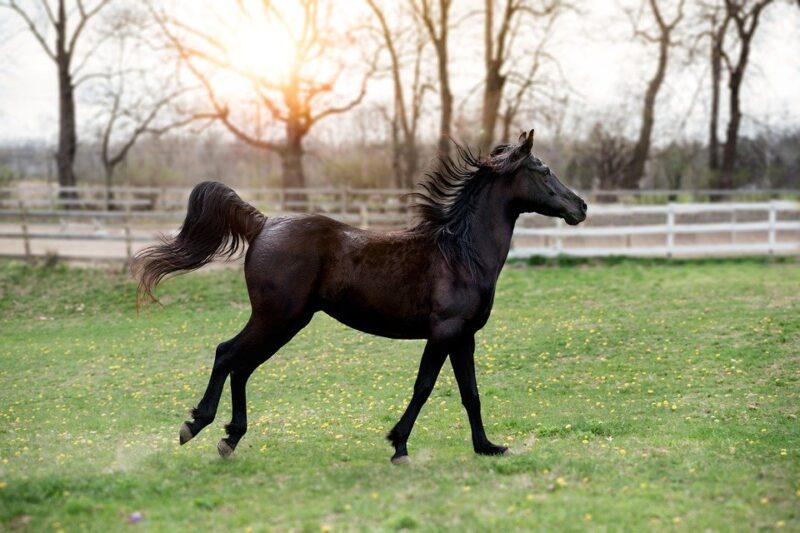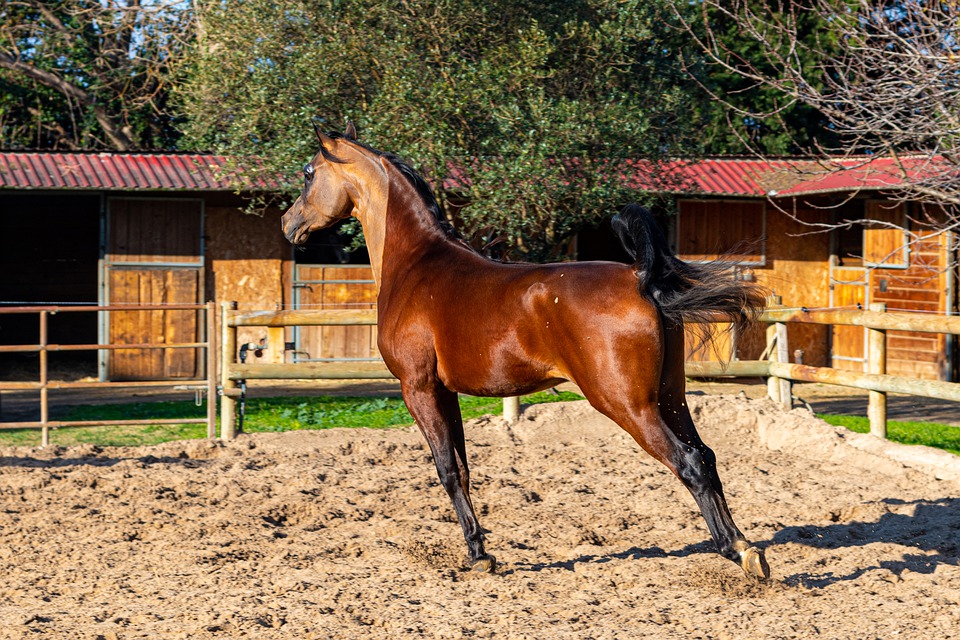What is play, why is it important for horses, and how can you ensure that your horse enjoys the opportunity to play? Let’s take a look at how to recognize equine play and how to target these behaviors with enrichment.

What is Equine Play?
Play has been defined as activities that involve pleasure and surprise but which have no immediate function for the animal – in other words, doing something that is enjoyable but doesn’t result in getting food, breeding, gaining access to shelter, and so on. This sounds pretty dry, because play can be hard to define – but we all know it when we see it.
In humans, at least.
When animals play, they perform their own behaviors rather than playing in a way that humans might. Play looks different in different species, including horses. Learning to recognize when a horse is playing is important to measuring how often the equines in your life are getting this vital behavioral opportunity, and how to fill in the gaps if needed. Horses play like horses rather than like human children, and it sometimes looks like just running, messing around with items in the pasture, or sparring with other horses. We can’t hear any happy giggles or excited shouts when horses play, but we can make a reasonable guess that they probably experience the fun and excitement of play like we do, and enjoy it just as much as kids or adults do. When you know how to recognize equine play and interpret what’s going on, watching them play becomes especially exciting.
Play behaviors in horses are entertaining for humans to watch, but more importantly, they are important for the horses performing them. Along with feeding, locomotion, and self-maintenance behaviors, play behaviors can be encouraged using enrichment. Giving horses the opportunity to play allows them to experience its benefits and may improve the horse’s mental state, which is a great reason to include enrichment that focuses on bringing out play in your horse’s behavioral care program.
Play behaviors are often modified or ritualized versions of other, survival-important behaviors such as aggression, prey capture (for predatory animals), locomotion, breeding, and so on. When an animal plays, the difference between the play actions and its “real” counterparts – the difference between a play fight and a real, serious encounter, for instance – is signaled by a difference in the animal’s body language and expressions. Animals can generally tell the difference between the playful and serious behaviors of others. Animals including horses can either play by themselves, or engage in social play that involves interacting with others.
Why play? Apart from being enjoyable and stimulating, play is a physically healthy activity that provides exercise. When horses play, they move and flex in ways that keep their bodies in good shape. Play also allows horses to practice social and survival skills, such as running from predators or defending themselves, in a safe and positive way. Social play is also important for solidifying relationships between animals, just like children building friendships and practicing social skills while on playdates.
Just as there are lots of different types of play in human beings, horses play in different ways. These behaviors can be targeted using specific enrichment techniques to ensure that horses have the opportunity to express different play behaviors at a healthful frequency.
Object Play
When horses play with things in their environment, by manipulating objects, they’re engaging in object play. We can think of this much like humans playing with toys, but horses don’t have hands to pick up and manipulate objects – instead, they nibble, lift, carry, and throw items as a form of play.
Some objects can be pulled or tugged, which has been observed in foals pulling on the tails of other horses. In addition to manipulating objects with their heads and teeth, horses will also paw at objects. Pawing is a common form of water play, where horses splash water around by pawing enthusiastically at it.
Horses will also use objects as “anchors” for locomotor play, running to and from an object in their environment such as a tree, or circling an object at any gait.
Object play is a lot of fun to encourage using enrichment items. A horse in an empty stall or pasture can’t do much in the way of object play, so you can provide them with opportunities to interact with objects by supplying items for them to play with. Jolly Balls, yoga balls and giant beach balls, sticks, and stuffed animals are all great enrichment items for promoting object play.
Locomotor Play

Locomotor play is the term used for playing that involves motion. These movements are distinct and recognizable, occurring in similar ways across equines from domestic horses and ponies to donkeys to wild zebra.
Horses frolic, run, chase one another, jump, and buck while playing. Watching horses play is exciting and enjoyable for people as much as the activity is healthy and fun for the horses at play. The best way to promote healthy locomotor play at appropriate frequency is to provide a large enough environment for play to occur, ensure that horses are comfortable and secure in their environment, and provide appropriate herd structure so that horses are better able to encourage their herdmates to join in bouts of locomotor play.
Play Fighting
Have you ever watched two young horses sparring with one another, complete with shoving, biting, and even rearing and striking out? It looks as if they’re pretending to be stallions, fighting to rule the herd – and, in a way, they are. Play fighting lets horses practice both the physical and the social components of a real fight without fear of serious consequences. It’s endearingly similar to kids staging mock battles, or to students sparring in a wrestling or martial arts gym.
Horses perform physical aggression and defense for a variety of reasons. As mentioned above and in the Social Behaviors page, stallions compete with one another for breeding rights in a harem. Horses may also claim or defend resources; although we want our domesticated horses to have ample sources of food, water, and shelter, horses are very capable of resource aggression and defense when they feel a sense of scarcity, and fighting behaviors can be observed in this context. Mares will defend their offspring vigorously, and horses will fight if they cannot flee from a predator.
So even outside the context of breeding competition, fighting is an important part of the equine behavioral repertoire, and play fighting is a way to practice and maintain those skills – from the precursor behaviors and social signals that set the stage for the battle, to the physical combat itself, to the behaviors that signal the end of a fight.
Horses play using the same behaviors they could use in a real fight: biting and snapping; grasping the other horse by the back of the neck or mane; shoving and pushing with the neck, rearing and striking, and kicking out with the hindquarters. When observing horses, it’s usually clear to people that the activity is less intense and the intent of the horses is less serious, but sometimes it can be difficult to tell (especially for new learners of equine behavior). Sometimes, the play fighting behavior looks a lot like a small game or wrestling match between horses rather than a “pretend fight.” When horses stand facing each other and take turns attempting to nip each other’s necks, it bears a lot of resemblance to a couple rounds of thumb war between kids.
The Importance of Play
How important is play behavior in horses? There is a growing body of evidence that play deprivation (the subject’s environment or physical/mental state preventing play, or lack of opportunity to play) has serious negative impacts on humans and other animals. Animals that cannot play appear to have trouble interacting socially in other ways, growing into adults with poor social connections. As of now, these studies have been done mostly in laboratory animals with some research into human children, but it is reasonable to err on the opinion that play is probably just as important for horses. Play appears to be highly enjoyable for both young and adult horses, on top of allowing them to practice important social and physical behaviors. Plus, it provides horses with exercise that keeps them active and moving without any need for human intervention. All we have to do is provide the right care and environment to the horse, along with some enrichment items and activities, to encourage horses to engage in this beneficial, species-appropriate behavior.
Enrichment for Play
Play is a really fun category of behaviors to focus your enrichment efforts on – it can be a challenge to draw out play behaviors in horses, but it’s very rewarding to see horses get better at playing and more interested in the enrichment opportunities that encourage play. Plus, this is a set of behaviors that aren’t food-based – so if you’re ready to move beyond forage boxes and snuffle mats (as much fun as they are!), equine play is an ideal behavior group to focus your enrichment efforts on.
Some horses appear to prefer certain types of play, just like some kids prefer team sports while others would rather play with blocks – play is a highly individual set of behaviors. You may already know what kinds of activity your horse is drawn to the most, from running and cavorting to sparring with herdmates to picking up and investigating objects. Your job is to offer plenty of opportunity for them to participate in the kinds of play they already enjoy, and set the stage for other play behaviors to occur as well.
Before focusing on items and activities for this behavior, make sure that the rest of the horse’s lifestyle is conducive to play. Since play is not required for survival, it may be “backburnered” if more urgent needs are not met – if an equine-appropriate diet, social structure, and overall environment aren’t available to the horse, or if they are experiencing physical or emotional distress, they may not be able or willing to devote any energy or effort into playing. Compare this to your own life and you’ll probably feel very similar: it’s difficult or impossible to enjoy hobbies if we’re ill, in the middle of a big life change, or dealing with major stress. Also, many play categories – like locomotor play, or play fighting – can’t occur in a stall environment, so this is another reason to provide turnout in a herd environment.
To promote object play, provide a horse will plenty of objects that might spark their curiosity and trigger a bout of play. Sticks, tough and sturdy stuffed animals (or large dog toy plushes), and giant beach balls or yoga balls are potential additions to your enrichment shelf, and each one is used by the horse in a different way. For play that involves movement, try adding ground poles in your pasture to create variety in the horse’s movement patterns and give them something to move over and around during a bout of play.
Social play behaviors like chasing one another or play fighting are best promoted by keeping horses together in the pasture so that they can choose to play at any time. Horses with access to forage, with buddies nearby, and enough space to choose how far away from one another they like are horses whose needs are met and who can choose to play – and that’s a rewarding sight for any horse person.
Does your horse play? Have you set up enrichment that encouraged some awesome equine play behaviors? Leave a comment to share your story!
Sources
McDonnell and Poulin, 2002. Equid play ethogram. Applied Animal Behavior Science 78